Millimeter-Wave Dual-Band MIMO Channel Capacity Analysis Based on Climate Data: A Samsun Province Case Study
Abstract
:1. Introduction
1.1. Related Work on NYUSIM
1.2. Research Gaps of Previous Work on Channel Capacity Based on Climate Data
1.3. Contribution of This Paper
- We proposed a hybrid approach by integrating channel data (based on channel impulse response) generated by the NYUSIM simulator and real-world climate data collected in Samsun province, Turkey to understand channel capacity local to the area. In addition, this hybrid approach can be used to get early or baseline results in other countries or regions to analyze, test, develop, and evaluate the performance of wireless communication systems based on local climate data.
- The MIMO channel capacities were calculated using annual climate data and realistic channel models for urban microcell (UMi), urban macrocell (UMa), and rural macrocell (RMa) areas.
- The effects of 28 GHz and 39 GHz frequencies and both line-of-sight and non-line-of-sight conditions on channel capacity have been studied in detail.
- The channel models were designed for 28 GHz and 39 GHz frequencies and both line-of-sight (LOS) and non-line-of-sight (NLOS) conditions.
- It was determined which of the rain rate, temperature, humidity, and pressure parameters had the greatest effect on the channel capacity.
- The results obtained in this study can assist system designers in analyzing the performance of MIMO systems, determining the maximum data rate that can be supported under different channel conditions, and optimizing system parameters to achieve the desired performance.
2. Background
2.1. NYUSIM Channel Simulator
2.1.1. Path Loss Model
2.1.2. MIMO-OFDM
2.2. MIMO Channel Capacity
3. Simulation Setup
4. Results and Discussion
4.1. Capacity Analysis Results for UMi
4.2. Capacity Analysis Results for UMa
4.3. Capacity Analysis Results for RMa
4.4. Comparison of Annual Average Channel Capacity Analysis in All Environments
5. Conclusions
Author Contributions
Funding
Data Availability Statement
Acknowledgments
Conflicts of Interest
References
- Xiong, B.; Zhang, Z.; Jiang, H.; Zhang, J.; Wu, L.; Dang, J. A 3D Non-Stationary MIMO Channel Model for Reconfigurable Intelligent Surface Auxiliary UAV-to-Ground mmWave Communications. IEEE Trans. Wirel. Commun. 2022, 21, 5658–5672. [Google Scholar] [CrossRef]
- Huang, Z.; Cheng, X. A 3-D Non-Stationary Model for Beyond 5G and 6G Vehicle-to-Vehicle mmWave Massive MIMO Channels. IEEE Trans. Intell. Transp. Syst. 2021, 23, 8260–8276. [Google Scholar] [CrossRef]
- Hemadeh, I.A.; Satyanarayana, K.; El-Hajjar, M.; Hanzo, L. Millimeter-Wave Communications: Physical Channel Models, Design Considerations, Antenna Constructions, and Link-Budget. IEEE Commun. Surv. Tutor. 2017, 20, 870–913. [Google Scholar] [CrossRef]
- Yuan, Z.; Zhang, J.; Ji, Y.; Pedersen, G.F.; Fan, W. Spatial Non-Stationary Near-Field Channel Modeling and Validation for Massive MIMO Systems. IEEE Trans. Antennas Propaga. 2022, 71, 921–933. [Google Scholar] [CrossRef]
- Al-Saman, A.; Cheffena, M.; Elijah, O.; Al-Gumaei, Y.A.; Rahim, S.K.A.; Al-Hadhrami, T. Survey of Millimeter-Wave Propagation Measurements and Models in Indoor Environments. Electronics 2021, 10, 1653. [Google Scholar] [CrossRef]
- Zhang, P.; Li, J.; Wang, H.; You, X. Millimeter-Wave Space-Time Propagation Characteristics in Urban Macrocell Scenarios. In Proceedings of the ICC 2019—2019 IEEE International Conference on Communications (ICC), Shanghai, China, 20–24 May 2019; pp. 1–6. [Google Scholar] [CrossRef]
- Huang, J.; Wang, C.-X.; Chang, H.; Sun, J.; Gao, X. Multi-Frequency Multi-Scenario Millimeter Wave MIMO Channel Measurements and Modeling for B5G Wireless Communication Systems. IEEE J. Sel. Areas Commun. 2020, 38, 2010–2025. [Google Scholar] [CrossRef]
- Wang, Y.; Zhang, Z.; Liao, X.; Tian, Y.; Zhou, J.; Zhang, J. Propagation Measurement and Channel Characteristics of Small Office OAM Communication at 30 GHz. IEEE Antennas Wirel. Propag. Lett. 2022, 22, 839–843. [Google Scholar] [CrossRef]
- Nguyen, C.; Cheema, A.A. A Deep Neural Network-Based Multi-Frequency Path Loss Prediction Model from 0.8 GHz to 70 GHz. Sensors 2021, 21, 5100. [Google Scholar] [CrossRef]
- Lin, Z.; Lin, M.; Champagne, B.; Zhu, W.-P.; Al-Dhahir, N. Secrecy-Energy Efficient Hybrid Beamforming for Satellite-Terrestrial Integrated Networks. IEEE Trans. Commun. 2021, 69, 6345–6360. [Google Scholar] [CrossRef]
- Lin, Z.; Niu, H.; An, K.; Wang, Y.; Zheng, G.; Chatzinotas, S.; Hu, Y. Refracting RIS-Aided Hybrid Satellite-Terrestrial Relay Networks: Joint Beamforming Design and Optimization. IEEE Trans. Aerosp. Electron. Syst. 2022, 58, 3717–3724. [Google Scholar] [CrossRef]
- An, K.; Lin, M.; Ouyang, J.; Zhu, W.-P. Secure Transmission in Cognitive Satellite Terrestrial Networks. IEEE J. Sel. Areas Commun. 2016, 34, 3025–3037. [Google Scholar] [CrossRef]
- An, K.; Liang, T.; Zheng, G.; Yan, X.; Li, Y.; Chatzinotas, S. Performance Limits of Cognitive-Uplink FSS and Terrestrial FS for Ka-Band. IEEE Trans. Aerosp. Electron. Syst. 2018, 55, 2604–2611. [Google Scholar] [CrossRef]
- Saad, W.; Bennis, M.; Chen, M. A Vision of 6G Wireless Systems: Applications, Trends, Technologies, and Open Research Problems. IEEE Netw. 2019, 34, 134–142. [Google Scholar] [CrossRef]
- Al-Falahy, N.; Alani, O.Y. Millimetre wave frequency band as a candidate spectrum for 5G network architecture: A survey. Phys. Commun. 2019, 32, 120–144. [Google Scholar] [CrossRef]
- Ntaikos, D.; Gizas, B.; Papageorgiou, G.; Papadias, C.B. Channel Model Simulator for Multi-Antenna Terrestrial Links. In Proceedings of the 2017 IEEE International Conference on Communications Workshops (ICC Workshops), Paris, France, 21–25 May 2017. [Google Scholar]
- Jaeckel, S.; Raschkowski, L.; Borner, K.; Thiele, L. QuaDRiGa: A 3-D Multi-Cell Channel Model With Time Evolution for Enabling Virtual Field Trials. IEEE Trans. Antennas Propag. 2014, 62, 3242–3256. [Google Scholar] [CrossRef]
- Hoppe, R.; Wolfle, G.; Jakobus, U. Wave propagation and radio network planning software WinProp added to the electromagnetic solver package FEKO. In Proceedings of the 2017 International Applied Computational Electromagnetics Society Symposium-Italy (ACES), Firenze, Italy, 26–30 March 2017. [Google Scholar] [CrossRef]
- Sun, S.; MacCartney, G.R.; Rappaport, T.S. A novel millimeter-wave channel simulator and applications for 5G wireless communications. In Proceedings of the 2017 IEEE International Conference on Communications (ICC), Paris, France, 21–25 May 2017; pp. 1–7. [Google Scholar] [CrossRef]
- Ju, S.; Kanhere, O.; Xing, Y.; Rappaport, T.S. A Millimeter-Wave Channel Simulator NYUSIM with Spatial Consistency and Human Blockage. In Proceedings of the 2019 IEEE Global Communications Conference (GLOBECOM), Waikoloa, HI, USA, 9–13 December 2019; pp. 1–6. [Google Scholar] [CrossRef]
- He, Y.; Zhang, Y.; Zhang, J.; Pang, L.; Chen, Y.; Ren, G. Investigation and Comparison of QuaDRiGa, NYUSIM and MG5G Channel Models for 5G Wireless Communications. In Proceedings of the 2020 IEEE 92nd Vehicular Technology Conference (VTC2020-Fall), Vietual Conference, 18 November–16 December 2020. [Google Scholar]
- Lübke, M.; Dimce, S.; Schettler, M.; Lurz, F.; Weigel, R.; Dressler, F. Comparing mmWave channel simulators in vehicular environments. In Proceedings of the 2021 IEEE 93rd Vehicular Technology Conference (VTC2021-Spring), Virtual Conference, 25 April–19 May 2021. [Google Scholar]
- Alizadeh, A.; Vu, M.; Rappaport, T.S. A Study of Interference Distributions in Millimeter Wave Cellular Networks. In Proceedings of the 2019 IEEE International Conference on Microwaves, Antennas, Communications and Electronic Systems (COMCAS), Tel-Aviv, Israel, 4–6 November 2019; pp. 1–6. [Google Scholar] [CrossRef]
- Rappaport, T.S.; Sun, S.; Shafi, M. Investigation and Comparison of 3GPP and NYUSIM Channel Models for 5G Wireless Communications. In Proceedings of the 2017 IEEE 86th Vehicular Technology Conference (VTC-Fall), Toronto, ON, Canada, 24–27 September 2017; pp. 1–5. [Google Scholar] [CrossRef]
- Sun, S.; Rappaport, T.S.; Shafi, M.; Tang, P.; Zhang, J.; Smith, P.J. Propagation Models and Performance Evaluation for 5G Millimeter-Wave Bands. IEEE Trans. Veh. Technol. 2018, 67, 8422–8439. [Google Scholar] [CrossRef]
- Zeman, K.; Masek, P.; Stusek, M.; Hosek, J.; Silhavy, P. Accuracy comparison of propagation models for mmWave communication in NS-3. In Proceedings of the 2017 9th International Congress on Ultra Modern Telecommunications and Control Systems and Workshops (ICUMT), Munich, Germany, 6–8 November 2017. [Google Scholar]
- Hasan, R.; Mowla, M.; Hoque, N. Performance Estimation of Massive MIMO Drop-based Propagation Channel Model for mmWave Communication. In Proceedings of the 2020 IEEE Region 10 Symposium (TENSYMP), Dhaka, Bangladesh, 5–7 June 2020; pp. 461–464. [Google Scholar] [CrossRef]
- Mowla, M.; Dutty, H.B.H.; Ahmad, I. A Statistical mmWave Channel Modeling for Backhaul Networks in 5G Communications. In Proceedings of the 2019 International Conference on Computer, Communication, Chemical, Materials and Electronic Engineering (IC4ME2), Rajshahi, Bangladesh, 11–12 July 2019; pp. 1–4. [Google Scholar] [CrossRef]
- Zekri, A.B.; Ajgou, R. Study of mmWave channels for different scenarios. In Proceedings of the 2019 6th International Conference on Image and Signal Processing and their Applications (ISPA), Mostaganem, Algeria, 24–25 November 2019. [Google Scholar]
- Lodro, M.M.; Majeed, N.; Khuwaja, A.A.; Sodhro, A.H.; Greedy, S. Statistical channel modelling of 5G mmWave MIMO wireless communication. In Proceedings of the 2018 International Conference on Computing, Mathematics and Engineering Technologies (iCoMET), Sukkur, Pakistan, 3–4 March 2018; pp. 1–5. [Google Scholar] [CrossRef]
- Rahayu, Y.; Pohan, I.A. 38 GHz Channel Modeling for 5G Communication at Pekanbaru City. In Proceedings of the 2021 IEEE Symposium on Future Telecommunication Technologies (SOFTT), Bandung, Indonesia, 6–7 December 2021. [Google Scholar]
- Momo, S.H.A.; Mowla, M. Statistical Analysis of an Outdoor mmWave Channel Model at 73 GHz for 5G Networks. In Proceedings of the 2019 International Conference on Computer, Communication, Chemical, Materials and Electronic Engineering (IC4ME2), Rajshahi, Bangladesh, 11–12 July 2019; pp. 1–4. [Google Scholar] [CrossRef]
- Hasan, R.; Mowla, M.; Rashid, A.; Hosain, K.; Ahmad, I. A Statistical Analysis of Channel Modeling for 5G mmWave Communications. In Proceedings of the 2019 International Conference on Electrical, Computer and Communication Engineering (ECCE), Cox’s Bazar, Bangladesh, 7–9 February; pp. 1–6. [CrossRef]
- Ilyas, R.; Malik, A.; Alammari, A.A.; Sharique, M. 5G and mmWave MIMO Channel Models: Simulations and Analysis. In Proceedings of the 2021 Sixth International Conference on Wireless Communications, Signal Processing and Networking (WiSPNET), Chennai, India, 25–27 March 2021. [Google Scholar]
- Játiva, R.; Salazar, A.; Toscano, W. Reference models for 5G wireless communications channels. In Proceedings of the 2019 IEEE Fourth Ecuador Technical Chapters Meeting (ETCM), Guayaquil, Ecuador, 13–15 November 2019. [Google Scholar]
- Samimi, M.K.; Sun, S.; Rappaport, T.S. MIMO channel modeling and capacity analysis for 5G millimeter-wave wireless systems. In Proceedings of the 2016 10th European Conference on Antennas and Propagation (EuCAP), Davos, Switzerland, 10–15 April 2016; pp. 1–5. [Google Scholar] [CrossRef]
- Zhang, K.; Zhang, R.; Wu, J.; Jiang, Y.; Tang, X. Measurement and modeling of path loss and channel capacity analysis for 5G UMa scenario. In Proceedings of the 2019 11th International Conference on Wireless Communications and Signal Processing (WCSP), Xi’an, China, 23–25 October 2019. [Google Scholar]
- Zhai, M.; Li, J.; Liang, Y.; Li, T.; Gui, G.; Li, F. A novel coupling mode based 3D MIMO channel modeling and capacity analysis for 5G. In Proceedings of the 2016 IEEE International Conference on Ubiquitous Wireless Broadband (ICUWB), Nanjing, China, 16–19 October 2016; pp. 1–4. [Google Scholar] [CrossRef]
- Abdullah-Al-Nahid, S.; Khan, T.A.; Taseen, M.A.; Tasnim, S.; Marium, T.; Baki, A.K.M. Comparison of Condition Numbers and Ranks of the MIMO Channel at 77 GHz Carrier Frequency. In Proceedings of the 2021 5th International Conference on Electrical Engineering and Information & Communication Technology (ICEEICT), Dhaka, Banglades, 18–20 November 2021. [Google Scholar]
- Hikmaturokhman, A.; Suryanegara, M.; Ramli, K. A comparative analysis of 5G channel model with varied frequency: A case study in Jakarta. In Proceedings of the International Conference on Smart Computing & Communications, Sarawak, Malaysia, 28–30 June 2019. [Google Scholar]
- Squali, L.; Riouch, F. Atmospheric parameters influence on mm-wave propagation in 5G communication. In Proceedings of the 2019 7th Mediterranean Congress of Telecommunications (CMT), Fes, Morocco, 24–25 October 2019. [Google Scholar] [CrossRef]
- Kurniawan, A.; Danisya, A.R.; Isnawati, A.F. Performance of mmWave Channel Model on 28 GHz Frequency Based on Temperature Effect in Wonosobo City. In Proceedings of the 2020 IEEE International Conference on Communication, Networks and Satellite (Comnetsat), Batam, Indonesia, 17–18 December 2020; pp. 37–41. [Google Scholar] [CrossRef]
- Rahman, M.N.; Anwar, K.; Nur, L.O. Indonesia 5G Channel Model Considering Temperature Effects at 28 GHz. In Proceedings of the 2019 Symposium on Future Telecommunication Technologies (SOFTT), Kuala Lumpur, Malaysia, 18–19 November 2019. [Google Scholar] [CrossRef]
- Budalal, A.A.; Rafiqul, I.; Habaebi, M.; Rahman, T.A. The effects of rain fade on millimetre wave channel in tropical climate. Bull. Electr. Eng. Inform. 2019, 8, 653–664. [Google Scholar] [CrossRef]
- Prasetyo, A.H.; Suryanegara, M.; Asvial, M. Evaluation of 5G Performance at 26 GHz and 41 GHz frequencies: The Case of Tropical Suburban Areas in Indonesia. In Proceedings of the 2019 IEEE 14th Malaysia International Conference on Communication (MICC), Selangor, Malaysia, 2–4 December 2019; pp. 101–105. [Google Scholar] [CrossRef]
- Larasati, S.; Yuliani, S.R.; Danisya, A.R. Outage Performances of 5G Channel Model Influenced by Barometric Pressure Effects in Yogyakarta. J. Infotel 2020, 12, 25–31. [Google Scholar] [CrossRef]
- Al-Shuwaili, A.; Jamel, T.M. 5G Channel Characterization at Millimeter-Wave for Baghdad City: An NYUSIM-based Approach. In Proceedings of the 2021 18th International Multi-Conference on Systems, Signals & Devices (SSD), Monastir, Tunisia, 22–25 March 2021; pp. 468–473. [Google Scholar] [CrossRef]
- Alfaresi, B.; Nawawi, Z.; Malik, R.F.; Anwar, K.; Nur, L.O. Humidity Effect to 5G Performances under Palembang Channel Model at 28 GHZ. Sinergi 2019, 24, 49–56. [Google Scholar] [CrossRef]
- Budalal, A.A.; Shayea, I.; Islam, R.; Azmi, M.H.; Mohamad, H.; Saad, S.A.; Daradkeh, Y.I. Millimetre-Wave Propagation Channel Based on NYUSIM Channel Model With Consideration of Rain Fade in Tropical Climates. IEEE Access 2021, 10, 1990–2005. [Google Scholar] [CrossRef]
- Kola, A.F.; Kurnaz, Ç. Analysis of MIMO Channel Capacity at 28/73 GHz with NYUSIM Channel Simulator. Int. J. Eng. Res. Dev. 2023, 15, 212–218. [Google Scholar] [CrossRef]
- Roy, P.; Vishwakarma, R.K.; Jain, A.; Singh, R. Multiband millimeter wave antenna array for 5G communication. In Proceedings of the 2016 International Conference on Emerging Trends in Electrical Electronics & Sustainable Energy Systems (ICETEESES), Sultanpur, India, 11–12 March 2016. [Google Scholar]
- Lassabe, F.; Canalda, P.; Chatonnay, P.; Spies, F.; Baala, O. A Friis-based calibrated model for WiFi terminals positioning. In Proceedings of the Sixth IEEE International Symposium on a World of Wireless Mobile and Multimedia Networks, Giardini Naxos, Italy, 13–16 June 2005. [Google Scholar]
- Available online: https://samsun.mgm.gov.tr/istasyonlar.aspx (accessed on 14 May 2023).
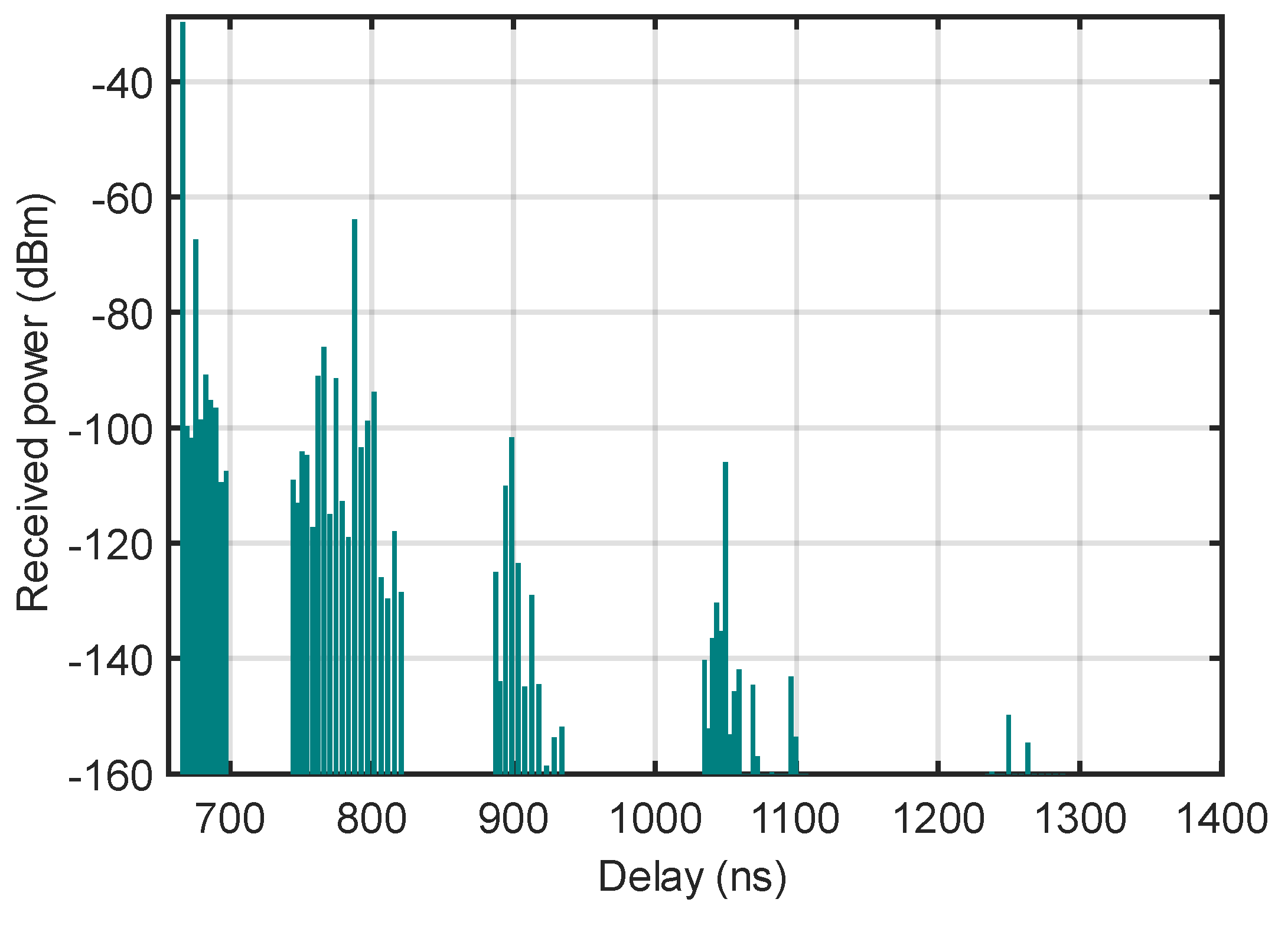
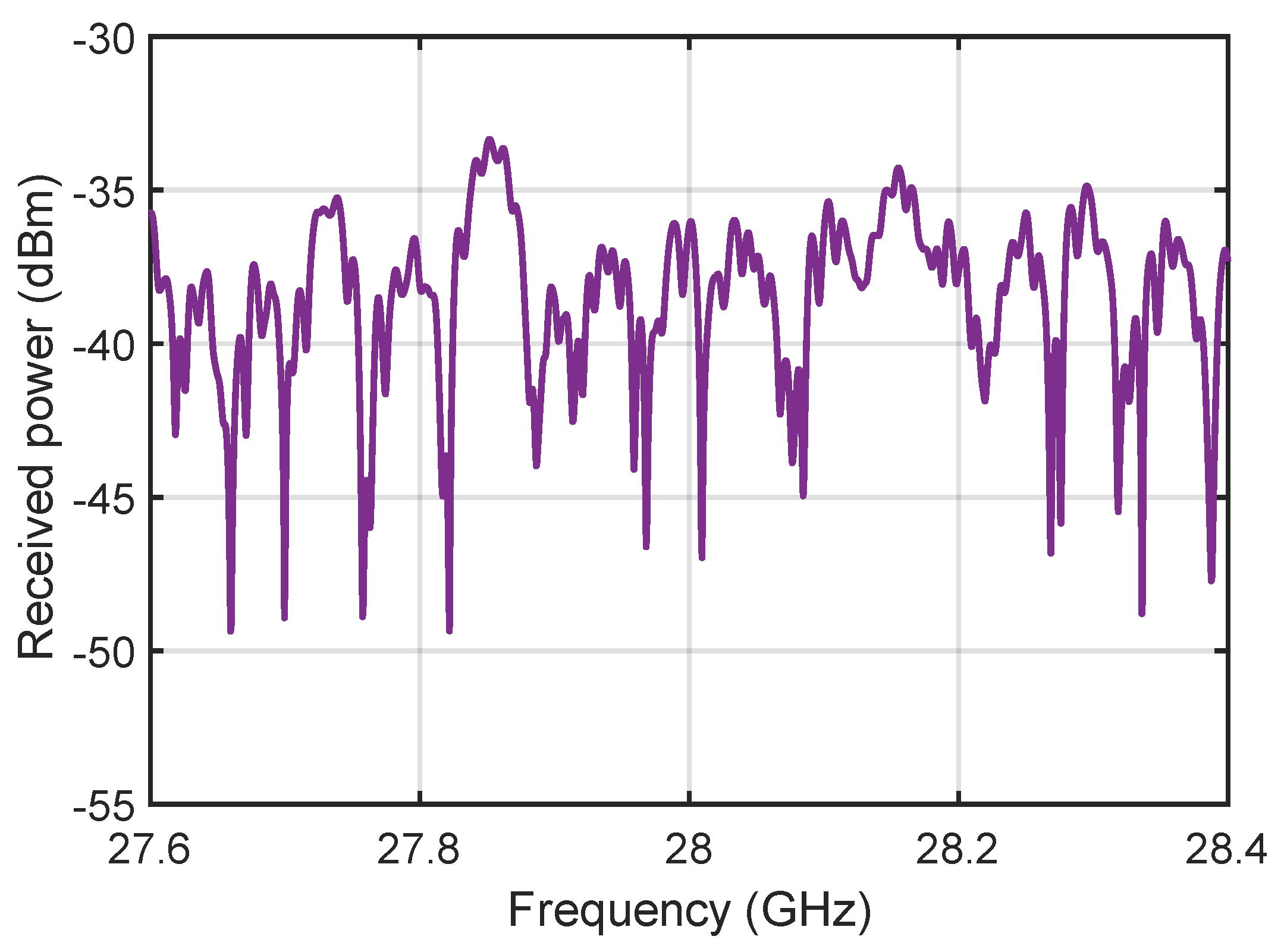
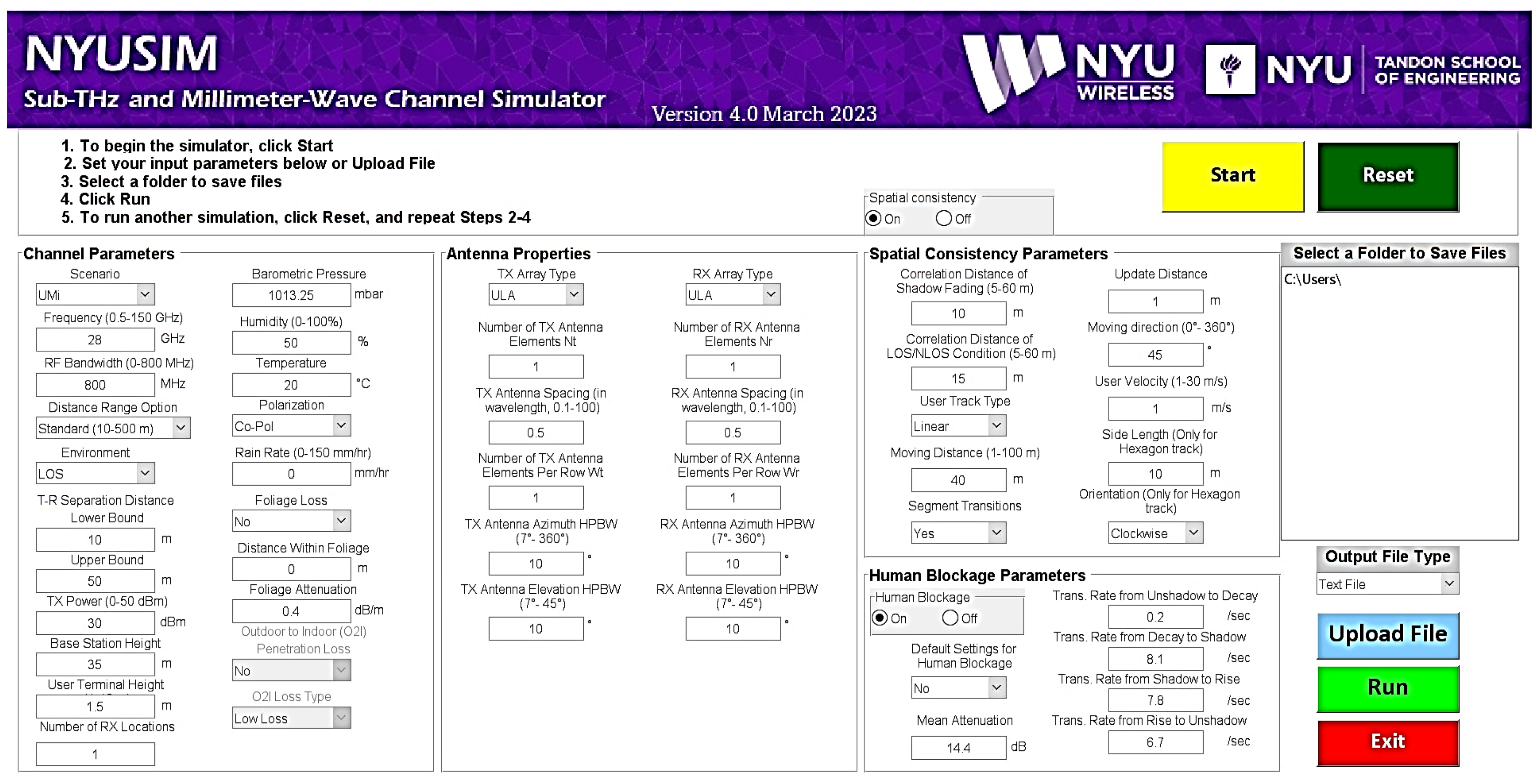

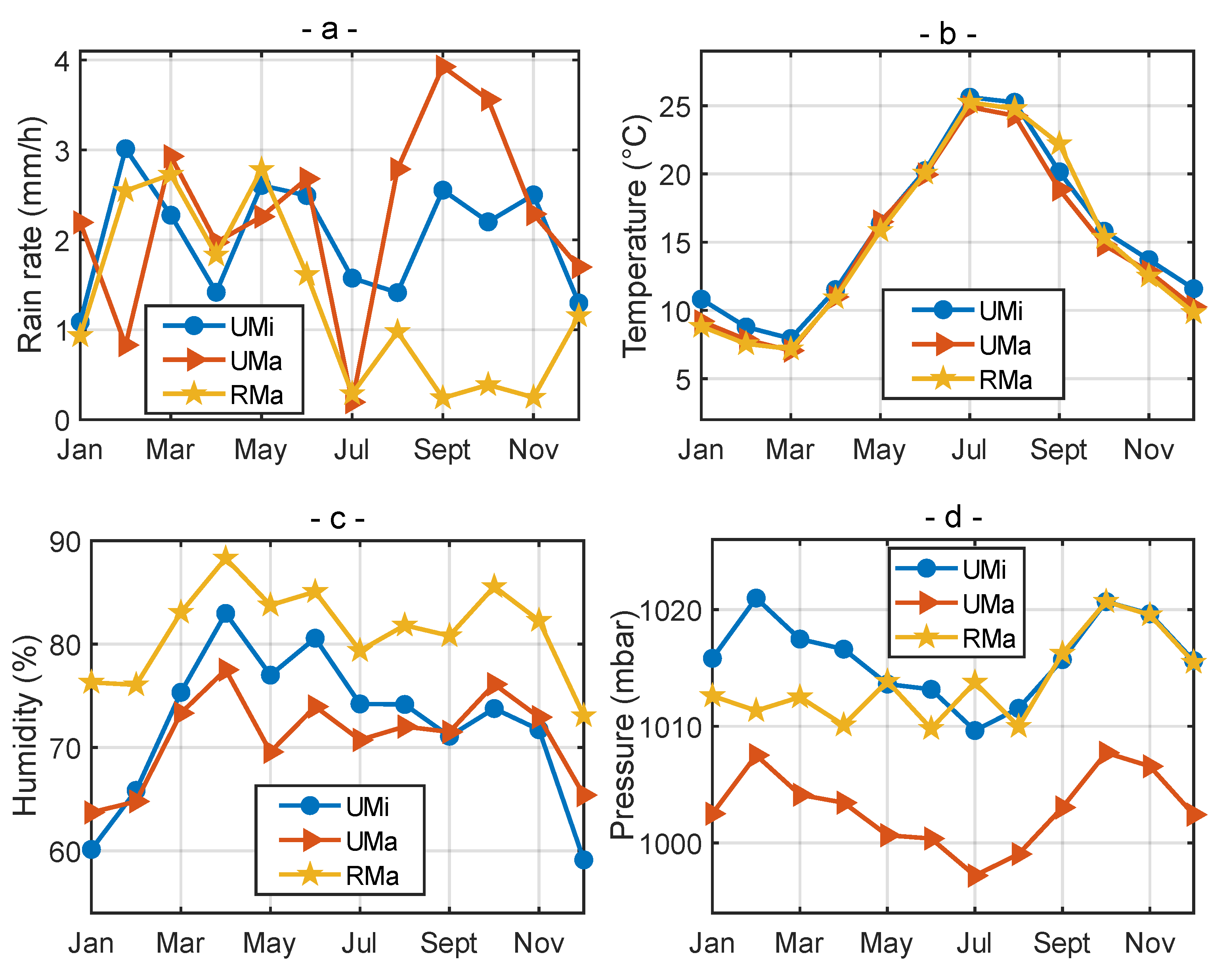
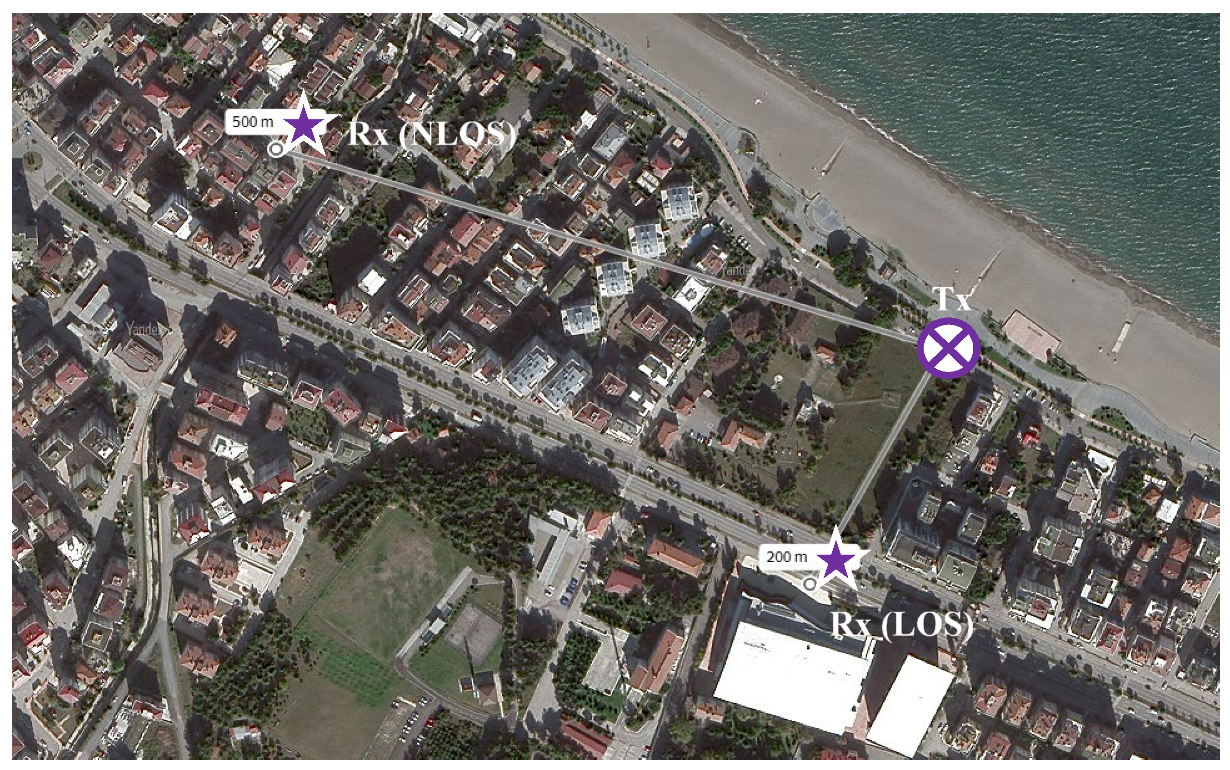


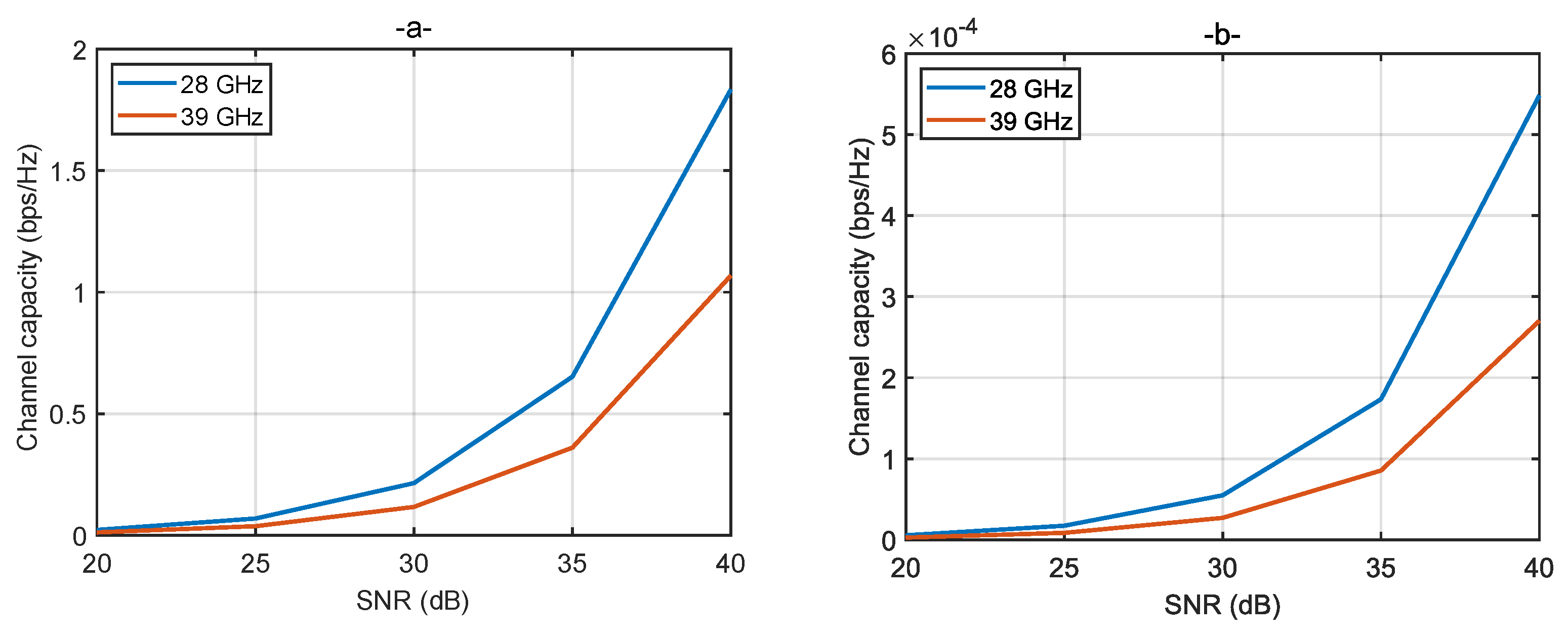







| Ref. | Scenario | Frequency (GHz) | Key Highlights |
|---|---|---|---|
| [1] | UAV-to-Ground Communications | 28 | A three-dimensional non-stationary wideband channel model |
| [2] | Vehicle-to-vehicle MIMO communication | 28 | A three-dimensional non-stationary irregular-shaped geometry-based stochastic model |
| [3] | Future wireless communication systems | 28, 38, 60, 73 | Propagation characteristics (i.e., path loss, atmospheric and rain attenuation) |
| [4] | Massive MIMO-based indoor communication | 26.5 to 32.5 | Multipath propagation mechanisms (i.e., LOS blockage, reflection, and diffraction) |
| [5] | Future wireless communication systems | 28 to 100 | The path loss model and analysis of path loss and delay spread |
| [6] | Urban macrocell | 28, 39 | Delay and angular spreads based on channel |
| [7] | Vehicular communication | 28, 32, 39 | The human body, vehicle blockage, outdoor path loss, and V2V measurements |
| [8] | Indoor communication | 30 | The path loss, K-factor, and rms delay spread |
| [9] | Cellular Communication | 0.8–70 | AI-based path loss modeling |
| Reference | Frequencies (GHz) | Scenarios | Environment | Distances (m) | Bandwidth (MHz) | Antenna | Climate Data | Real Field Measurements for Climate Data | Analysis |
|---|---|---|---|---|---|---|---|---|---|
| [29] | 38, 60, 73 | UMi | LOS NLOS | 100 | 800 | 1 × 1 | No | No | Path Loss |
| [34] | 28 | UMi | LOS | 10, 50, 100, 300 | 800 | 1 × 1 | No | No | PDF, BER |
| [35] | 28 | UMi, UMa | LOS, NLOS | 200 200, 500 | 200 | - | No | No | RMS Delay Spread, Received Power |
| [39] | 77 | UMi | NLOS | 200 | 800 | 2 × 2, 4 × 4 | No | No | Path Loss, Channel Capacity |
| [40] | 3.5, 26, 28 | UMi | NLOS | 200 | 200 | - | Rain Rate | No | Outage Probability |
| [41] | 6, 28, 38, 60, 73, 100 | UMi | - | 10–500 | - | - | Rain Rate, Humidity, Temperature, Pressure | No | Path Loss |
| [42] | 28 GHz | UMi | NLOS | - | 200 | - | Temperature | No | Outage Probability |
| [45] | 26, 41 | UMi | NLOS | 100, 500, 1000 | 200 | 64 × 64 | Rain Rate | No | Outage Capacity |
| [47] | 28, 45, 60, 73 | UMa | LOS | 50 | 800 | 2 × 2 | Humidity, Temperature | No | Received Power |
| [48] | 28 | UMi | NLOS | 200 | 400 | - | Humidity | No | Outage Probability |
| [49] | 38 | UMi | LOS | 300 m | 800 | 1 × 1 | Rain Rate | Yes | Path Loss, Received Power |
| [50] | 28, 73 | UMi | LOS, NLOS | 200 m | 800 | 2 × 2, 4 × 4 8 × 8 16 × 16 32 × 32 64 × 64 | Rain Rate, Humidity, Temperature, Pressure | No | Channel Capacity |
| This work | 28, 39 | UMi, UMa, RMa | LOS, NLOS | 200 500 | 800 | 4 × 4 | Rain Rate, Humidity, Temperature, Pressure | Yes | Channel Capacity |
| Channel Parameters | Scenarios | ||
|---|---|---|---|
| Samsun | Bafra | Ondokuzmayıs | |
| Scenario | UMi | UMa | RMa |
| Frequency | 28/39 GHz | ||
| Environment | LOS/NLOS | ||
| Distances | 200 m (LOS)/500 m (NLOS) | ||
| Bandwidth | 800 MHz | ||
| MIMO | 4 × 4 | ||
| Tx Power | 30 dB | ||
| BS Height | 20 m | ||
| User Height | 1.5 m | ||
| Correlation Coefficient | Rain Rate | Temperature | Humidity | Pressure |
|---|---|---|---|---|
| UMi-UMa | 0.18 | 0.99 | 0.86 | 0.99 |
| UMi-RMa | 0.31 | 0.99 | 0.93 | 0.46 |
| UMa-RMa | −0.16 | 0.99 | 0.92 | 0.49 |
| UMi | UMa | RMa | ||
|---|---|---|---|---|
| Rain rate (mm/h) | Max | 3.01 | 3.92 | 2.78 |
| Min | 1.08 | 0.19 | 0.24 | |
| Average | 2.03 | 2.27 | 1.31 | |
| Temperature (°C) | Max | 25.61 | 24.90 | 25.24 |
| Min | 7.93 | 7.05 | 7.17 | |
| Average | 15.65 | 14.78 | 15.02 | |
| Humidity (%) | Max | 82.97 | 77.52 | 88.31 |
| Min | 59.13 | 63.72 | 73.07 | |
| Average | 72.16 | 70.96 | 81.29 | |
| Pressure (mbar) | Max | 1020.98 | 1007.72 | 1020.68 |
| Min | 1009.63 | 997.20 | 1009.98 | |
| Average | 1015.98 | 1002.93 | 1013.82 |
| Correlation Coefficient | Rain Rate | Temperature | Humidity | Pressure | ||
|---|---|---|---|---|---|---|
| Channel capacity | 28 GHz | LOS | −0.74 | 0.66 | −0.04 | −0.61 |
| NLOS | −0.90 | 0.16 | −0.14 | −0.49 | ||
| 39 GHZ | LOS | −0.75 | 0.20 | 0.05 | −0.58 | |
| NLOS | −0.83 | 0.34 | 0.06 | −0.54 | ||
| Correlation Coefficient | Rain Rate | Temperature | Humidity | Pressure | ||
|---|---|---|---|---|---|---|
| Channel capacity | 28 GHz | LOS | −0.87 | −0.03 | −0.47 | −0.45 |
| NLOS | −0.66 | 0.29 | −0.43 | −0.70 | ||
| 39 GHZ | LOS | −0.80 | 0.16 | −0.43 | −0.53 | |
| NLOS | −0.76 | 0.19 | −0.42 | −0.54 | ||
| Correlation Coefficient | Rain Rate | Temperature | Humidity | Pressure | ||
|---|---|---|---|---|---|---|
| Channel capacity | 28 GHz | LOS | −0.97 | 0.43 | −0.20 | 0.63 |
| NLOS | −0.96 | 0.41 | −0.04 | 0.44 | ||
| 39 GHZ | LOS | −0.91 | 0.39 | 0.03 | 0.51 | |
| NLOS | −0.75 | 0.23 | −0.23 | 0.54 | ||
| Ref. | Year | Analysis | Frequency (GHz) | LOS/NLOS | MIMO | Results |
|---|---|---|---|---|---|---|
| [3] | 2017 | Received Power, Number of Antenna Elements | 28, 38, 60, 73 | LOS/NLOS | - | As frequencies go up, the number of antennas needed grows exponentially. Frequencies of 57, 60, and 64 GHz are not suitable for outdoor use |
| [29] | 2019 | Path Loss | 38, 60, 73 | LOS/NLOS | 1 × 1 | 60 GHz is more impacted by environmental changes, whereas 38 GHz is more resilient to environmental factors. |
| [40] | 2019 | Outage Probability | 26, 28 | - | - | Rainfall of 150 mm/hour results in signal loss of 5.4894 dB at 28 GHz, 5.1135 dB at 26 GHz, and 2.0533 dB at 3.5 GHz. |
| [47] | 2021 | Received Power | 28, 45, 73 | LOS | 2 × 2 | At 28 GHz, power efficiency is highest, while at 45 GHz, resistance to seasonal atmospheric changes is strongest. |
| [49] | 2021 | Path Loss, Received Power | 38 | LOS | 1 × 1 | Rain attenuation exceeds 15 dB at 38 GHz and has an impact of over 1 dB within 200 m transceiver distances. |
| [50] | 2023 | Channel Capacity | 28, 73 | LOS/NLOS | 2 × 2 to 64 × 64 | Increasing from 2 × 2 to 64 × 64 results in a 36.88× capacity increase, using 28 GHz instead of 73 GHz provides a 12.56× increase, and switching from NLOS to LOS leads to a 307.7× increase in channel capacity. |
| This Study | 2023 | Channel Capacity | 28, 39 | LOS/NLOS | 4 × 4 | UMi and UMa have higher channel capacity than RMa for LOS, while for NLOS, UMa has the highest capacity and UMi has the lowest. There is a strong negative correlation between channel capacity and rain rate. |
Disclaimer/Publisher’s Note: The statements, opinions and data contained in all publications are solely those of the individual author(s) and contributor(s) and not of MDPI and/or the editor(s). MDPI and/or the editor(s) disclaim responsibility for any injury to people or property resulting from any ideas, methods, instructions or products referred to in the content. |
© 2023 by the authors. Licensee MDPI, Basel, Switzerland. This article is an open access article distributed under the terms and conditions of the Creative Commons Attribution (CC BY) license (https://creativecommons.org/licenses/by/4.0/).
Share and Cite
Kola, A.F.; Kurnaz, Ç.; Cheema, A.A.; Rahimian, A. Millimeter-Wave Dual-Band MIMO Channel Capacity Analysis Based on Climate Data: A Samsun Province Case Study. Electronics 2023, 12, 2273. https://doi.org/10.3390/electronics12102273
Kola AF, Kurnaz Ç, Cheema AA, Rahimian A. Millimeter-Wave Dual-Band MIMO Channel Capacity Analysis Based on Climate Data: A Samsun Province Case Study. Electronics. 2023; 12(10):2273. https://doi.org/10.3390/electronics12102273
Chicago/Turabian StyleKola, Ahmet Furkan, Çetin Kurnaz, Adnan Ahmad Cheema, and Ardavan Rahimian. 2023. "Millimeter-Wave Dual-Band MIMO Channel Capacity Analysis Based on Climate Data: A Samsun Province Case Study" Electronics 12, no. 10: 2273. https://doi.org/10.3390/electronics12102273
APA StyleKola, A. F., Kurnaz, Ç., Cheema, A. A., & Rahimian, A. (2023). Millimeter-Wave Dual-Band MIMO Channel Capacity Analysis Based on Climate Data: A Samsun Province Case Study. Electronics, 12(10), 2273. https://doi.org/10.3390/electronics12102273










